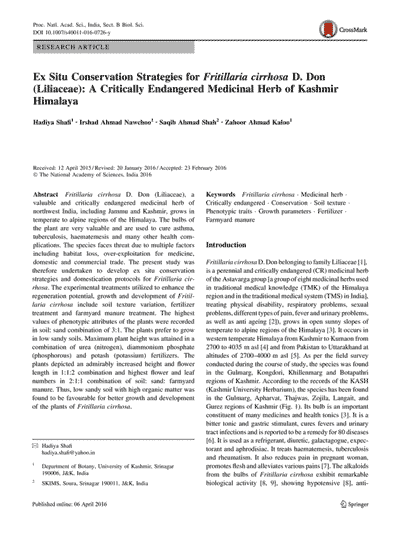NEWS 2016
Ex Situ Conservation Strategies for Fritillaria cirrhosa D. Don (Liliaceae): A Critically Endangered Medicinal Herb of Kashmir Himalaya
Hadiya SHAFI¹, Irshad Ahmad NAWCHOO¹, Saqib Ahmad SHAH², Zahoor Ahmad KALOO¹
Proceedings of the National Academy of Sciences, India Section B: Biological Sciences (2016)
doi: 10.1007/s40011-016-0726-y
¹Department of Botany, University of Kashmir, Srinagar, 190006, J&K, India
²SKIMS, Soura, Srinagar, 190011, J&K, India
Abstract
Fritillaria cirrhosa D. Don (Liliaceae), a valuable and critically endangered medicinal herb of northwest India, including Jammu and Kashmir, grows in temperate to alpine regions of the Himalaya. The bulbs of the plant are very valuable and are used to cure asthma, tuberculosis, haematemesis and many other health complications. The species faces threat due to multiple factors including habitat loss, over-exploitation for medicine, domestic and commercial trade. The present study was therefore undertaken to develop ex situ conservation strategies and domestication protocols for Fritillaria cirrhosa. The experimental treatments utilized to enhance the regeneration potential, growth and development of Fritillaria cirrhosa include soil texture variation, fertilizer treatment and farmyard manure treatment. The highest values of phenotypic attributes of the plants were recorded in soil: sand combination of 3:1. The plants prefer to grow in low sandy soils. Maximum plant height was attained in a combination of urea (nitrogen), diammonium phosphate (phosphorous) and potash (potassium) fertilizers. The plants depicted an admirably increased height and flower length in 1:1:2 combination and highest flower and leaf numbers in 2:1:1 combination of soil: sand: farmyard manure. Thus, low sandy soil with high organic matter was found to be favourable for better growth and development of the plants of Fritillaria cirrhosa.




